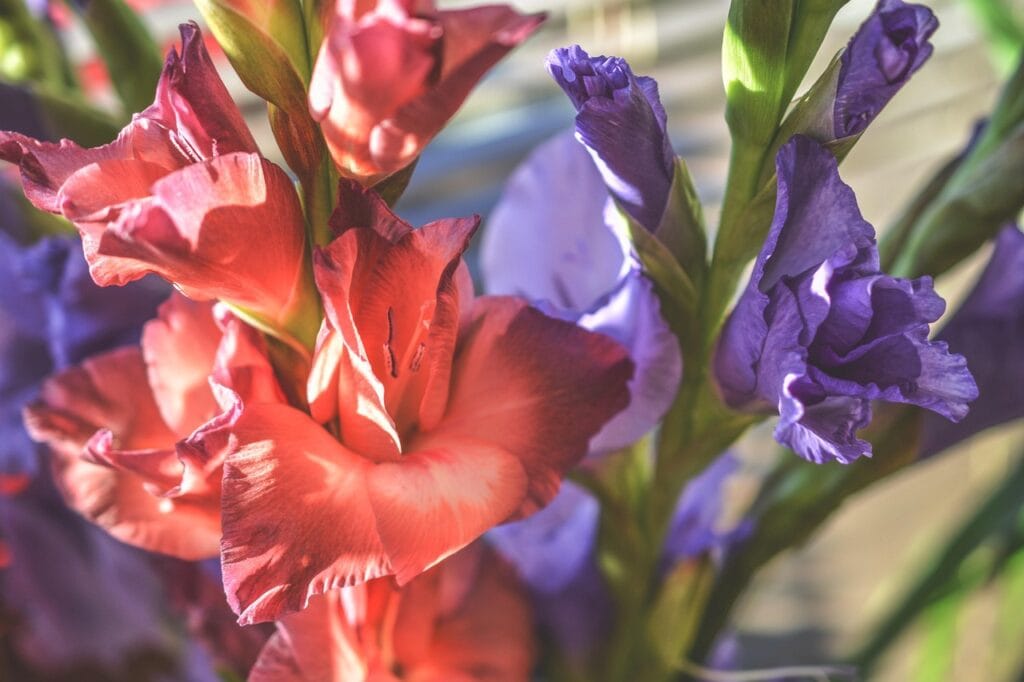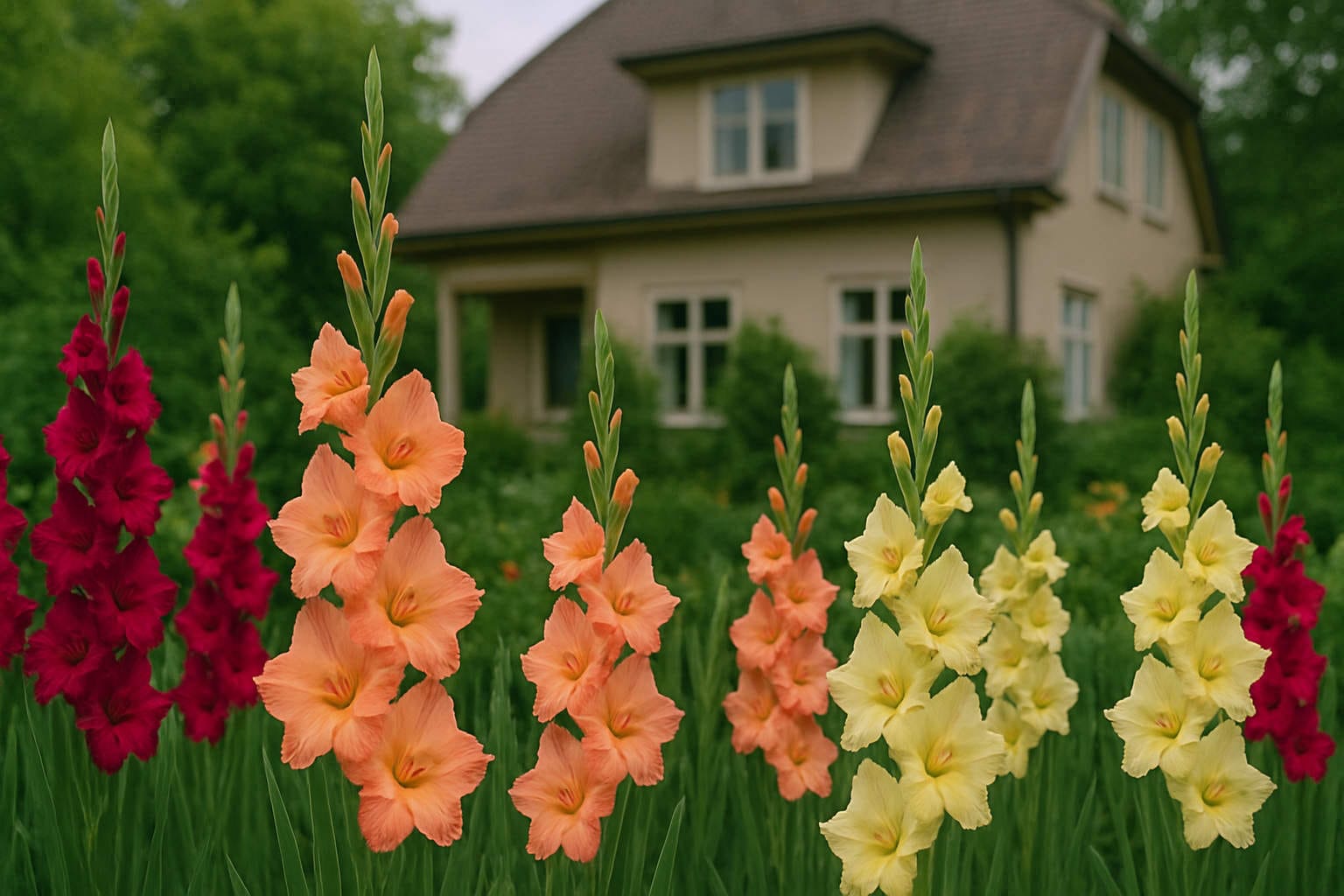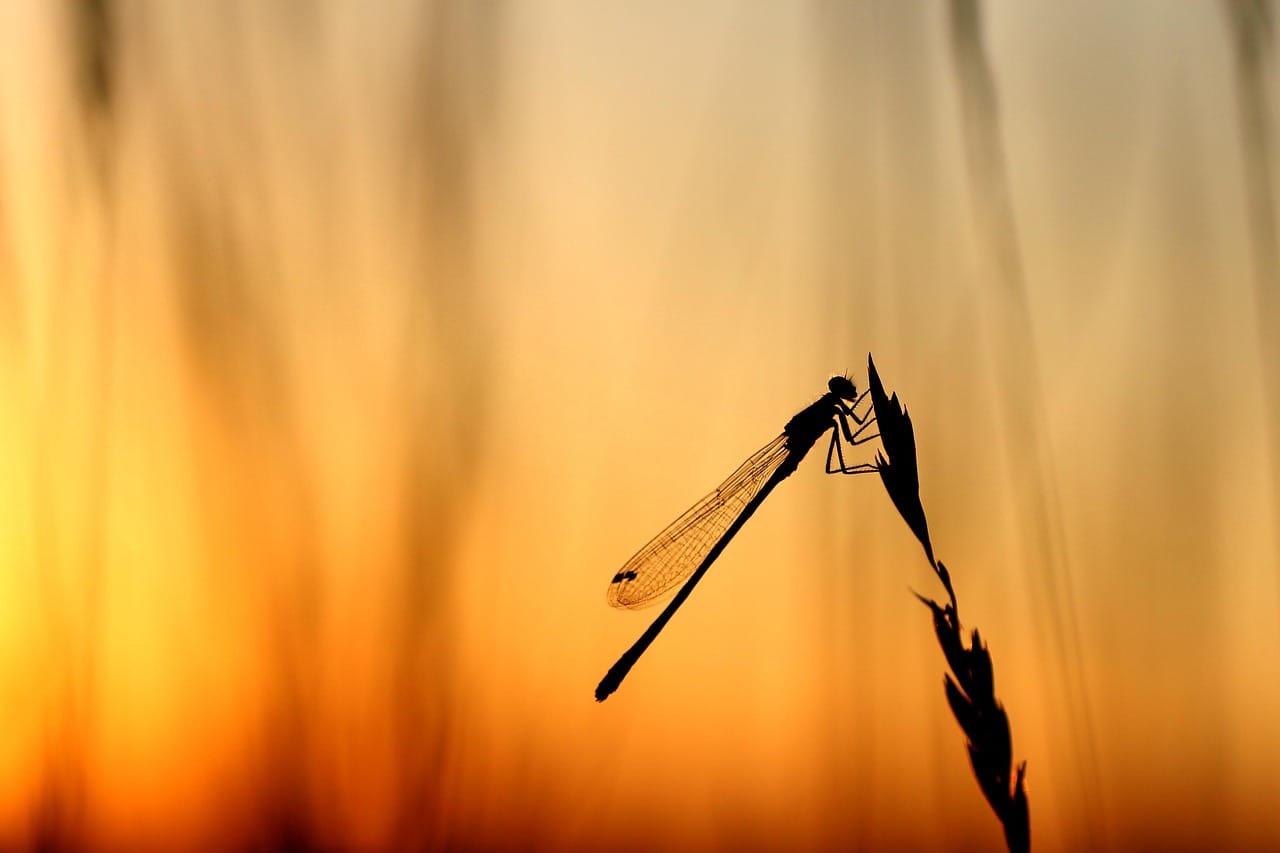If you’re dreaming of tall, colorful blooms that add instant drama to your garden, the gladiola flower might be exactly what you’re missing. These striking plants are easy to grow, surprisingly versatile, and full of personality.
In this guide, we’re diving into everything you need to know about gladiolas: where they come from, what they mean, how to plant them, how to take care of them, and why they might be one of the most underrated flowers out there.
Stick around, because by the end of this guide, you won’t just know what a gladiola is—you’ll be ready to grow them like a pro.
What Is a Gladiola Flower? A Quick Introduction
Alright, let’s get clear on what we’re talking about. The gladiola flower—also known as gladiolus or gladioli (yep, that’s the plural)—is a flowering plant that stands out for its tall, sword-like stems lined with bold, funnel-shaped blooms.
These flowers don’t whisper. They show up, stand tall (literally), and demand a little attention.
Gladiolas belong to the Iris family (Iridaceae) and are grown from corms, which are like little underground storage units—think of them as tougher cousins of bulbs.
The plants can reach up to 4 feet tall, and depending on the variety, they bloom in just about every color you can imagine: red, white, yellow, purple, pink, even green.
They usually bloom in mid to late summer, and each stem can produce a long row of flowers that open from the bottom up. That’s part of what makes them awesome in floral arrangements—you get days of fresh-looking blooms from a single spike.
While they’re often seen in bouquets and formal arrangements, gladiolas also look great in the garden, especially in borders, cutting gardens, and flower beds where you want some vertical action.
If you’ve never grown a flowering plant from a corm before, don’t worry. Gladiolas are beginner-friendly, forgiving, and satisfying to grow. And once they bloom? You’ll wonder why you didn’t plant them sooner.
You may also like:
- Grow Milkweed in Pots or Gardens: A Complete Care Guide
- Iris Flower Care 101: How to Grow Stunning Irises in Your Garden
A Brief History and Meaning Behind the Name
So where did the gladiola flower come from, and what’s with the sword talk? Let’s break it down.
The name gladiolus comes from the Latin word gladius, which means “sword.” It’s a nod to the plant’s long, pointed leaves that look a lot like—you guessed it—a blade. That’s why you’ll sometimes hear it called the sword lily, even though it’s not technically a lily.
Gladiolas are native to South Africa, the Mediterranean, and parts of Asia, but they’ve been loved and cultivated all over the world for centuries. In fact, many of the hybrids we grow today come from South African species.
Dutch growers (especially in the Netherlands) turned the gladiolus into a global flower by developing hundreds of cultivated varieties. If you’ve ever seen one in a floral shop or garden center, chances are it came from Dutch corm farms.
In terms of naming:
- Gladiolus is the formal name.
- Gladiola is the more casual, commonly used version (especially in the U.S.).
- Gladioli is the correct plural, though “gladiolas” is also widely accepted.
These flowers have also carried some strong symbolic weight over the years. In ancient Rome, gladiators were often showered with gladiolus petals after a victory—hence their connection to strength, honor, and resilience.
That symbolism stuck around, and today, gladiolas are still seen as flowers of remembrance and moral integrity.
Cool history, right? Not many garden flowers can say they were battle-tested.
You may also like:
- How to Grow Garden Sage at Home: Tips for Lush, Flavorful Plants
- Hummingbird Carpet Plant: Everything You Need to Know to Grow It
Symbolism and Cultural Significance
The gladiola flower carries real meaning. It has been tied to strong emotions and serious values, which is probably why it keeps popping up in ceremonies and floral arrangements that matter.
So, what does it symbolize? First and foremost:
- Strength of character
- Moral integrity
- Remembrance
- Infatuation (yep, seriously)
It’s that mix of power and emotion that gives the gladiola its unique identity. It’s often used in funerals and memorials, especially in the U.S., where it’s seen as a tribute to someone who lived with courage and honor.
But it’s not all heavy—it’s also a symbol of romance. Back in the day, giving someone gladiolus was like saying, “You’ve pierced my heart.” Kinda intense, but hey, flowers used to be the original love letters.
In some cultures, gladiolas show up in military commemorations or Victory Day celebrations, especially in places like Russia and Eastern Europe.
And in the Netherlands, runners in long-distance events are handed gladiolus stems at the finish line—a tradition rooted in Roman history.
The gladiola flower is a symbol you can plant, grow, and even give to tell a story—your story, someone else’s, or both.
You may also like:
- How to Make Orchids Bloom: A Complete Guide for Home Gardeners
- How to Protect Plants from Frost: 6 Proven Methods for a Healthy Garden
When and Where to Plant Gladiolas
If you want those tall, colorful gladiola flowers popping up in your garden, timing and location are key—but don’t worry, it’s not complicated.
Best Time to Plant
You’ll want to plant your gladiolus in spring, after the last frost has passed. In most parts of the U.S., that means April through June.
Gladiolas aren’t frost-hardy, so if you plant too early, a cold snap could ruin your corms before they even get going.
Want blooms all summer? Here’s a pro move: stagger your plantings. Plant a few corms every two weeks for a month or so. That way, you won’t get all your flowers at once—they’ll take turns blooming.
Choosing the Right Spot
Gladiolas love the sun—at least 6 hours a day, preferably more. They’ll sulk in the shade. Choose a spot with well-draining soil, because soggy roots lead to rot. Raised beds work great, but any sunny garden patch will do.
If your soil is heavy or clay-like, mix in some compost or sand to help it drain better. These plants aren’t super fussy, but they don’t want to sit in a puddle.
They also like a bit of space—you’ll need to plant them about 6 inches apart so they’re not fighting for room.
And since they can grow tall, think about planting them where they won’t shade out smaller plants (or where a gust of wind won’t knock them over).
Planning ahead now saves you headaches later—and gives you a much better show when bloom time comes.
You may also like:
How to Plant Gladiolus: Step-by-Step


Planting gladiola flowers is way easier than you might think. You don’t need a green thumb or fancy gear—just a bit of sunshine, some well-prepped soil, and the right depth.
Here’s how to do it right the first time.
Step 1: Pick Healthy Corms
Start with firm, plump corms—no mold, no mush, no weird soft spots. Bigger corms (about 1.5 inches wide) usually give you stronger plants with more flowers.
Step 2: Prep Your Soil
Find a spot with full sun and loose, well-drained soil. If the dirt is compacted, mix in compost or peat moss. That gives your gladiolus roots a better start and helps with drainage.
Step 3: Plant at the Right Depth
Dig a hole 4 to 6 inches deep and place the corm pointy side up. Cover with soil and gently pat it down. For spacing, go about 6 inches apart between each one—closer if you want a dense look, wider for more airflow.
Step 4: Water Well
After planting, give them a good soak. Then, keep the soil moist but not soggy while the corms are establishing roots. Once the green shoots appear, you’ll know things are moving.
Bonus Tip: Stagger for a Longer Bloom
Want flowers for weeks instead of just a few days? Plant some corms now, and more every two weeks for a month. It’s a simple way to stretch out your bloom time.
That’s it—you’ve just planted gladiolus. No greenhouse required.
You may also like:
Gladiolus Care Tips Throughout the Season
So your gladiola flowers are in the ground—what now?
Luckily, caring for them doesn’t involve constant fussing. Just a few smart habits and you’ll get strong plants with stunning blooms.
Watering: Keep It Even
Gladiolus like consistent moisture, especially while they’re growing and getting ready to bloom. That means watering when the top inch of soil feels dry—but don’t drown them. Water at the base to avoid fungal problems on the leaves.
In hot, dry spells, deep watering a couple times a week is better than shallow sprinkles every day.
Feeding: Light and Regular
Gladiolas appreciate a little food, but don’t overdo it. Use a balanced fertilizer (like 10-10-10) every 3 to 4 weeks during the growing season. Too much nitrogen? You’ll get more leaves and fewer flowers.
A top-dressing of compost around the base mid-season is a great boost too.
Staking: Give Them Support
These plants can grow 3 to 4 feet tall, and those big blooms get heavy. If you’re in a windy spot, you’ll want to stake them before they start to flop. A simple bamboo stick and some soft twine does the trick—nothing fancy.
Or, plant them near a fence or between sturdier plants for natural support.
Deadheading and Cutting
Cut flowers early in the day, when the lower buds are just opening. Leave a few leaves behind—your plant needs them to feed the corm.
And if you’re not cutting them? Snip off faded blooms to keep the plant looking tidy and encourage energy to go back into the corm.
With just a little attention, your gladiolas will repay you with weeks of tall, colorful flowers.
You may also like:
Dealing with Pests and Common Problems
Even though gladiola flowers are pretty tough, they’ve got a few enemies—mainly pests and rot. But don’t worry, most issues are easy to spot and fix before they get out of hand.
Watch Out for Thrips
Thrips are tiny, annoying bugs that suck the life out of gladiolus leaves and flowers. You’ll know they’re around if the leaves look silvery or streaked, or the flowers come out deformed.
What to do: Spray with neem oil or insecticidal soap once you spot signs, and keep things clean around your plants—thrips love dead plant matter.
Fungal Issues & Rot
Too much moisture or poor drainage can cause corm rot or fungal diseases like Botrytis (gray mold). Leaves might yellow early, or the corms might turn soft and mushy underground.
How to prevent it:
- Make sure your soil drains well.
- Water the base, not the leaves.
- Don’t crowd the plants—airflow matters.
Other Pests
Aphids and spider mites might show up too. They’re usually more of a nuisance than a disaster, but keep an eye out and treat with the same sprays if needed.
Basic Hygiene Goes a Long Way
Remove dead leaves and flowers, don’t let weeds take over, and avoid overwatering. Healthy plants can fight off most things before they become a real problem.
A little attention now means you won’t have to play catch-up later.
You may also like:
Overwintering and Storing Gladiolus Corms
If you live somewhere with cold winters (zones 6 and below), you’ll need to dig up your gladiola flowers at the end of the season. Gladiolus corms don’t survive a hard frost—so if you want to enjoy them again next year, here’s how to store them properly.
Step 1: Wait for the Right Time
Once the leaves turn yellow or brown in late summer or early fall, that’s your cue. The plant’s done for the year, and the corms have stored enough energy to bloom again next season.
Step 2: Dig Carefully
Use a hand fork or shovel to gently lift the corms out of the soil. Shake off the dirt, but don’t wash them—moisture can cause rot during storage.
You’ll probably find small baby corms (called cormels) attached to the base. You can save those too, but they take a couple of years to bloom.
Step 3: Cure and Store
Lay the corms out in a cool, dry, well-ventilated spot for about a week to 10 days. Once they’re dry, cut off the stems and roots, then brush off any remaining dirt.
Store them in paper bags, mesh bags, or cardboard boxes with holes for airflow. Toss in a little sawdust or dry peat moss to keep things dry. Keep them in a cool (around 40–50°F), dark place—like a basement or garage.
Bonus tip: Check them monthly. If you spot any that are moldy or soft, toss them before they affect the rest.
That’s it—spring rolls around, and you’ll be ready to plant again without buying new corms.
You may also like:
Companion Planting and Garden Design Ideas
Gladiolas are bold, upright flowers that bring instant vertical drama to your garden—but they don’t have to stand alone. With the right companions, your gladiola flowers can become part of a much bigger, better garden picture.
Good Companion Plants
Gladiolus pairs well with other sun-loving, summer-blooming flowers—especially those that offer contrast in shape or height. Here are a few solid combos:
- Dahlias: Similar bloom time, but bushier and rounder—great for balance.
- Lilies: Tall, elegant, and bloom alongside gladiolus.
- Zinnias or Marigolds: Shorter, compact plants that fill in the lower space and add extra color.
- Salvia or Lavender: Add a cool-toned contrast with their spiky blooms and help deter pests.
Avoid planting them with large, aggressive plants that might crowd them out or steal too many nutrients.
Where to Place Them
Because they grow tall (3–4 feet), gladiolas look best in the back of a flower bed or along fences and walls. You can also plant them in clumps or rows to create a striking backdrop or border.
And if you’re into cut flowers? Create a cutting garden section where you plant rows of gladiolus just for harvesting. It’s easier to stake and maintain that way, and you won’t feel guilty trimming them for a vase.
Design Tip
Mix gladiolus varieties in different colors, or go monochrome for a bold, modern look. Either way, you’re making a statement.
They’re more than just background flowers—they’re structure, color, and energy all in one.
You may also like:
Conclusion: Grow Gladiola Flowers with Confidence
So, are gladiola flowers worth adding to your garden? Absolutely.
They’re easy to plant, simple to care for, and they bring serious height, color, and presence to any outdoor space.
You don’t need to be a gardening expert to grow them successfully. With the right timing, a sunny spot, and a little attention through the season, you’ll be rewarded with tall, eye-catching blooms that make your garden look thoughtfully designed—even if you’re just winging it.
Give them a shot this season, and you might find yourself making room for even more next year.
Want more garden inspiration? Check out our full guide on how to grow and care for roses—another classic flower every home gardener should know.
FAQ – Gladiola Flower
1. When should I plant gladiolus corms?
Plant them in spring after the last frost, usually between April and June.
2. Do gladiola flowers come back every year?
In warm climates (zones 7–10), yes. In colder zones, dig up and store the corms over winter.
3. Can I grow gladiolus in containers?
Absolutely. Use a deep pot, well-draining soil, and stake the stems as they grow.
4. How long do gladiolus blooms last?
Each flower spike blooms for about 1 to 2 weeks. Staggering plantings extends the bloom season.
5. Do gladiolus need full sun?
Yes. They need at least 6 hours of direct sunlight each day to thrive and bloom well.
6. Are gladiola flowers toxic to pets?
Yes, mildly toxic to cats and dogs if eaten. Keep them out of reach if you have curious pets.
7. How do I keep gladiolus from falling over?
Stake them with supports or plant near sturdy neighbors. Wind and heavy blooms can cause bending.




